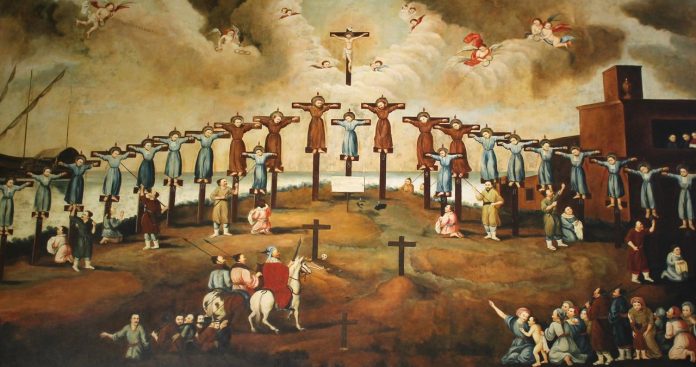Today, 6 February, is the feast of Saint Paul Miki and his (twenty-five) companions who were tortured and executed in Nagasaki, Japan, in 1597. “After Christ’s example, I forgive my persecutors. I do not hate them. I ask God to have pity on all, and I hope my blood will fall on my fellow men as a fruitful rain.”
How is it that we find Christians in sixteenth-century Japan? (There were some 300,000 of them in 1597!) The answer to that question is to be found in missionary work of Saint Francis Xavier (1502-52); he heard and responded to today’s readings. The Gospel provides the first part of his response; the second reading completes it. Christ’s commission to his disciples was to become “fishers of men.”[1] And what was to be their bait? Saint Paul tells us in that second reading: “For I delivered to you as of first importance what I also received, that Christ died for our sins in accordance with the Scriptures, that he was buried, that he was raised on the third day in accordance with the Scriptures.”[2] This statement embodies the power of religion, in that it responds to man’s deepest cravings. When Francis Xavier arrived in Japan on the Solemnity of the Assumption August 15th, 1549, the common religion was a form of ancestor worship, the essence of which is based on the conviction that there is something wonderful about being a human being. If I am extraordinary, it must have come to me by the same means as my physical existence, namely, by my having been generated by my parents, and their parents, and so on. Saint Francis could accept the insight and then deepen and extend it by the Christian teaching that we may indeed worship our ancestor—Christ—who gives us a new and wonderful birth in the waters of baptism by which we may join him in speaking of God as “Abba, Father.”[3]
After a period of openness to the West, Japan began a ferocious persecution of the Church in 1597. Christians died, apostatized or went underground. The country remained closed to all foreigners until the mid-nineteenth century. A treaty between France and Japan was ratified in 1859, and Catholic priests were free to open churches for the service of foreigners. In the new church at Nagasaki and 17 March 1865, occurred a memorable event when fifteen Christians made themselves known to Père Petitjean, assuring him that there were a great many others, about 50,000!
How were they to assure themselves that Père Petitjean represented the Catholic faith that they had guarded in secret for almost three hundred years? Would it be by his allegiance to the life-giving death and resurrection of Jesus? or by a trinitarian creed? But these are found in all forms of Christianity worthy of the name. According to the Catholic Encyclopedia, the there were three marks by which these Japanese Christians recognized the newcomers as Catholic:
- the authority of the Pope, that is, the role of the Magisterium in safeguarding the deposit of faith.
- veneration of the Blessed Virgin, which points to the importance of the devotional life of the Church
- the celibacy of the clergy which represents a radical commitment to the service of the Gospel.
How pleasing it is that any remaining Christians in hiding could, even today, distinguish Catholicism by these same three marks.
[1] Lk 5.11.
[2] 1 Cor 15.3-4
[3] Mk 14.16. Cf. Gal 4.6 and Rom 8.15,

